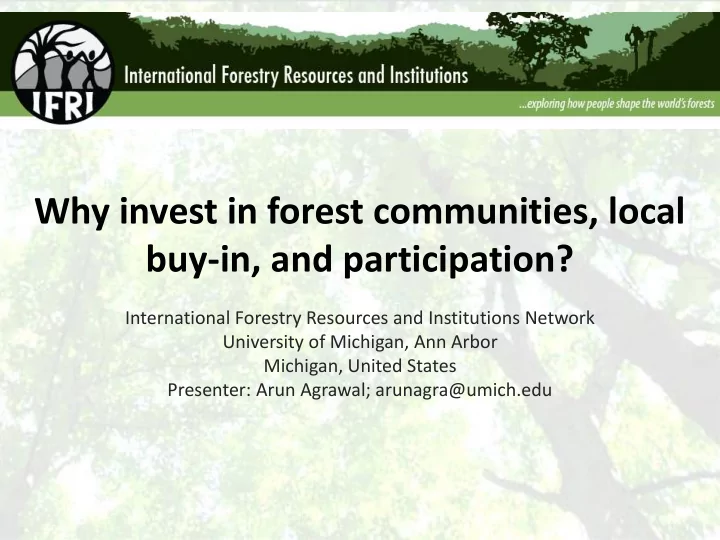

Why invest in forest communities, local buy-in, and participation? International Forestry Resources and Institutions Network University of Michigan, Ann Arbor Michigan, United States Presenter: Arun Agrawal; arunagra@umich.edu
1. What are the benefits? What are the alternatives • Two preceding presentations focused on downside risks of ignoring rights of communities and local populations • This presentation switches attention: the upside benefits of recognizing community and local population rights to forests: – Communities manage forests well for higher incomes, effective conservation, and better carbon sequestration – Nearly 40% of the global population resides in or near forests – they are not going anywhere 9/3/2015 2
2. Community management of land and forests 1. That communities can manage their collective resources capably is now well understood. 2. Key question – what can help them manage well? 3. Factors associated with better management differ 4. Two pieces of analysis that look at livelihoods, forest condition (carbon), and biodiversity
2.1 Can communities manage forest carbon and livelihoods well?
2.1 An early analysis of this question was carried out by Somanathan et al suggests that forests managed by local forest councils are in as good a condition as those by the forest department, and are managed at a fraction of the cost (PNAS 2009). Similar evidence exists for community management globally
2.11 Distribution of Studied Cases
Finding 1: Controlling for effects of other factors, as size of community forests increases: the likelihood of below average likelihoods of above outcomes on carbon and livelihoods average outcomes becomes lower, becomes greater. Implication – Recognition of community rights over larger forest areas is likely to lead to win-win outcomes for carbon and livelihoods
Finding 2: Controlling for effects of other factors, as communities have greater autonomy in managing their forests, below average outcomes on carbon and livelihoods less likely, and above average outcomes more likely. The area under the blue and red curves is the area of win-win that greater local autonomy produces Implication – policies giving more autonomy to communities likely to yield Win-Win outcomes on carbon and livelihoods
Finding 3a: when community Finding 3b: When community forest forest land is owned by the state, land is owned by communities, communities overuse communities conserve (and increase carbon sequestration) Speculation: New institutional design will be needed to compensate communities for reducing use of state- owned forests and create incentives to conserve the biomass and carbon on such forests – Revisit incentive design. stat. sig. at .01 level
2.2 Can communities manage livelihoods and forest diversity?
Examining diversity and livelihoods • 84 cases of forest commons from 6 countries in South Asia and East Africa • Broadly similar; somewhat larger forests in E. Africa, somewhat greater pop density in S. Asia; lower dependence in S. Asia for commercial benefits
Participation, livelihoods, and diversity (gologit estimation)
3.1 Implications for investment risk management • Communities are responsible managers, and with secure rights to larger forests can manage their forests effectively for positive conservation and livelihoods outcomes. • Communities with more autonomy in deciding how to manage their collective lands are more likely to know the value and capacities of that land, and to negotiate with investors • Governments in a number of countries – eg. Tanzania and Kenya, even as they support international investments in land, encourage investors to compensate communities for land they seek • More than 1.6 Billion people live within a 5Km radius of forests, globally. They are unlikely to go elsewhere – negotiations with local populations are a better strategy economically and ethically
3.2 Likely impacts of supporting and securing community rights • Better valuation of land and more decentralized distribution of financial benefits to local populations • Greater likelihood of investors only seeking the land they really need instead of large scale land transfers at low rates (in countries such as Ethiopia, Liberia, Kenya, Tanzania, less than 30% of allocated land is actually being used).
Recommend
More recommend